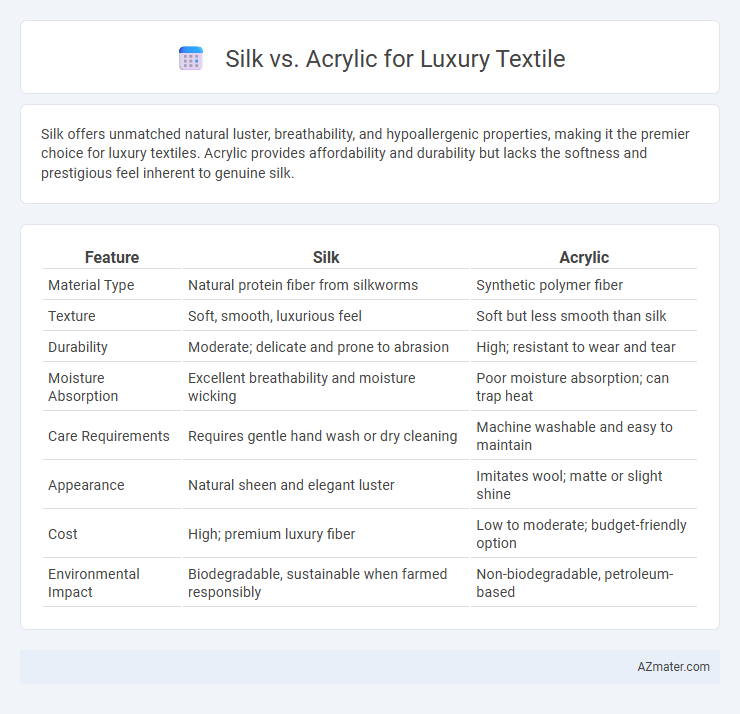Silk offers unmatched natural luster, breathability, and hypoallergenic properties, making it the premier choice for luxury textiles. Acrylic provides affordability and durability but lacks the softness and prestigious feel inherent to genuine silk.
Table of Comparison
| Feature | Silk | Acrylic |
|---|---|---|
| Material Type | Natural protein fiber from silkworms | Synthetic polymer fiber |
| Texture | Soft, smooth, luxurious feel | Soft but less smooth than silk |
| Durability | Moderate; delicate and prone to abrasion | High; resistant to wear and tear |
| Moisture Absorption | Excellent breathability and moisture wicking | Poor moisture absorption; can trap heat |
| Care Requirements | Requires gentle hand wash or dry cleaning | Machine washable and easy to maintain |
| Appearance | Natural sheen and elegant luster | Imitates wool; matte or slight shine |
| Cost | High; premium luxury fiber | Low to moderate; budget-friendly option |
| Environmental Impact | Biodegradable, sustainable when farmed responsibly | Non-biodegradable, petroleum-based |
Introduction to Luxury Textiles
Luxury textiles are defined by their exceptional quality, unique textures, and superior durability, with silk and acrylic representing two prominent fibers in this category. Silk, a natural protein fiber derived from silkworm cocoons, is prized for its natural luster, softness, and breathability, making it a timeless choice for high-end fashion and home decor. Acrylic, a synthetic fiber designed to mimic wool, offers affordability, color retention, and resistance to moths and mildew, often used to create luxurious-looking textiles with enhanced durability and ease of care.
Silk: Origins and Characteristics
Silk, a natural protein fiber produced by the Bombyx mori silkworm, has been prized for luxury textiles for over 5,000 years, originating in ancient China. Renowned for its smooth texture, natural sheen, breathability, and hypoallergenic properties, silk offers superior comfort and elegance compared to synthetic fibers like acrylic. Its strength, durability, and ability to absorb moisture while regulating temperature make silk the preferred choice for high-end fashion and home decor.
Acrylic: Manufacturing and Properties
Acrylic fibers are manufactured through the polymerization of acrylonitrile, producing a lightweight, durable, and colorfast synthetic fiber often used as a cost-effective alternative to silk in luxury textiles. This synthetic fiber offers excellent resistance to moisture, UV light, and chemicals, ensuring longevity and easy care, unlike the delicate nature of silk. Acrylic's ability to mimic the softness and sheen of natural fibers while providing enhanced durability makes it a popular choice in the luxury textile market.
Texture and Feel: Silk vs Acrylic
Silk offers a natural, smooth texture with a luxurious, soft feel that adapts to body temperature, providing breathability and comfort ideal for high-end textiles. Acrylic, by contrast, is a synthetic fiber that mimics wool but lacks the refined softness and breathability of silk, often feeling less supple and more plastic-like to the touch. For luxury textiles, silk's rich, lustrous finish and delicate hand make it the preferred choice over acrylic's synthetic and less tactile quality.
Durability and Longevity
Silk boasts natural strength and resilience due to its protein-based fibers, making it highly durable for luxury textiles while maintaining a soft and lustrous finish. Acrylic, a synthetic fiber, offers greater resistance to abrasion, mildew, and UV damage but may degrade faster under heat and prolonged wear. Silk's longevity in luxury textiles often surpasses acrylic when properly cared for, preserving elegance and texture over time.
Color Vibrancy and Fade Resistance
Silk exhibits exceptional color vibrancy due to its natural protein fibers that absorb dyes deeply, resulting in rich, luminous hues ideal for luxury textiles. Acrylic fibers, while often designed to mimic wool, offer impressive fade resistance and maintain color integrity under prolonged exposure to sunlight and washing. The superior dye affinity of silk ensures sustained brilliance, whereas acrylic's synthetic composition contributes to enhanced durability and long-lasting color retention.
Breathability and Comfort
Silk offers superior breathability and moisture-wicking properties, making it ideal for maintaining comfort in luxury textiles by regulating body temperature and reducing sweat accumulation. Acrylic, while lightweight and warm, lacks the natural breathability of silk and can trap heat, leading to less comfort in prolonged wear. For luxury textile applications prioritizing comfort and ventilation, silk remains the preferred choice due to its natural fibers and advanced moisture management capabilities.
Sustainability and Environmental Impact
Silk, a natural protein fiber produced by silkworms, is biodegradable and renewable, making it a more sustainable choice compared to acrylic, a synthetic fiber derived from petrochemicals with significant environmental footprints due to non-biodegradability and energy-intensive production. The cultivation of silk involves water and land use, but advances in "peace silk" methods reduce harm to silkworms and promote ethical practices. Acrylic manufacturing emits greenhouse gases and relies on fossil fuels, contributing to pollution and microplastic waste, which severely impacts ecosystems.
Price Comparison: Silk and Acrylic
Silk commands a significantly higher price than acrylic due to its natural origin, labor-intensive production, and luxurious texture, often ranging from $30 to $100 per yard versus acrylic's $5 to $15 per yard. The premium cost of silk reflects its superior durability and breathability, making it a preferred choice for high-end fashion and interior textiles. Acrylic, being a synthetic fiber, offers a budget-friendly alternative with easier maintenance but lacks the prestige and comfort associated with silk.
Choosing the Best Fabric for Luxury Textiles
Silk offers unparalleled natural sheen, breathability, and softness, making it the quintessential choice for luxury textiles that emphasize elegance and comfort. Acrylic, while more affordable and resistant to wrinkles and fading, lacks the sophisticated luster and moisture-wicking properties that define true luxury fabrics. Selecting the best fabric depends on prioritizing natural fibers' prestige and tactile richness over synthetic durability and cost-effectiveness.

Infographic: Silk vs Acrylic for Luxury textile
 azmater.com
azmater.com